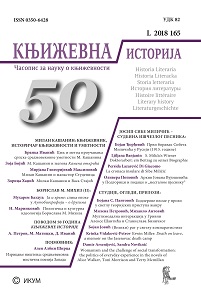Ја и време: слика епохе у Аутобиографији – о другима Борислава Михајловића Михиза
I and time: a picture of the epoch in Autobiogra¥ ja – o drugima by Borislav Mihajlović Mihiz
Author(s): Muharem BazduljSubject(s): Serbian Literature
Published by: Институт за књижевност и уметност
Keywords: Autobiography;Epoch;Yugoslavia;reception;public;Borislav Mihajlović Mihiz;
Summary/Abstract: The main aspect of this paper is an analysis of the way how famous Serbian essayist and critic Borislav Mihajlović Mihiz described first two decades of socialist Yugoslavia in his book Autobiografija – o drugima. Borislav Mihajlović (1922–1995) well known by his nickname Mihiz was a figure without precedent in Serbian and Yugoslav culture. He was most relevant and most widely known literary critic in socialist Yugoslavia, although he was openly anti-communist. Although Autobiografija – o drugima was first published when communist era was already over, the book is not simplistic and black-and-white. In describing his own life and lives of the people he knew well Mihiz manages to sketch complex picture of the epoch. He first focuses on the group of his friends who will later all become important artists and intellectuals. During the end of the forties they all lived together on the same address (Simina 9A in Belgrade) and among them some were communists and some were not. However, personal relations made at the time during the youth were very significant afterwards and it was quite often than some high rank communist would be able to help a friend who made some political faux pas.Mihiz afterwards describes his role as a literary critic in NIN, the most prestigious news magazine in Yugoslavia, as well as his dealings with Ivo Andric, both before and after he won Nobel Prize for literature. Also, one of the crucial moments in the book is his peculiar friendship with Milovan Djilas, the only real high profile Yugoslav dissident. In this paper, the relation is commented also from the other side with quotations about Mihiz from Djilas’ work. In the end, there were also Mihiz’s ties with some people from Yugoslav secret services, as well as the description since 1968 and student rebellion. In addition, in the final part of the paper there is investigation about the reception of this book in the time of its first publication and also to this day. Although widely considered as a sort of masterpiece, there are also some views harshly critical, but more towards the author than the book itself. In these interpretations Borislav Mihajlović Mihiz as a figure is seen as a symbol of anti-Yugoslav sentiments in Serbian society. However, his book Autobiografija – o drugima proves to be much more nuanced that these views suggest. His description of the epoch thus becomes valuable source.
Journal: Књижевна историја
- Issue Year: 50/2018
- Issue No: 165
- Page Range: 73-86
- Page Count: 14
- Language: Serbian

